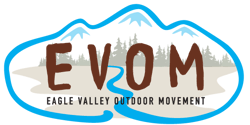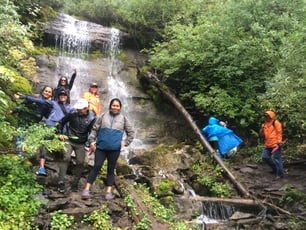Cierre de áreas de vida silvestre
EVOM
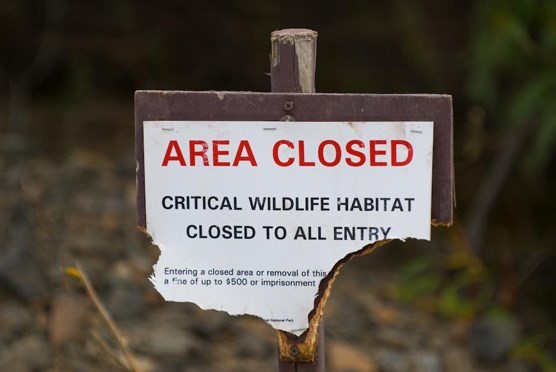
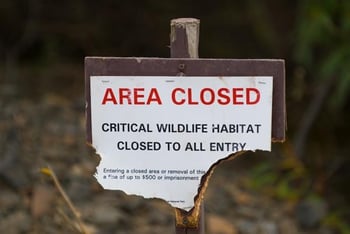
Al igual que la gente local y visitantes en el condado Eagle cerca del comienzo de la temporada de esquí, la vida silvestre está en movimiento. ¿Has notado?
El invierno en el condado de Eagle es difícil para los ciervos y los alces. Sus alimentos favoritos y áreas de pastoreo se cubren de nieve, por lo que deben moverse para encontrar pastos que puedan sostenerlos durante nuestro largo invierno. Los alces, por su gran tamaño, buscan un lugar para relajarse y ahorrar energía. Los ciervos buscan comida, ya que no pueden almacenar tanta energía como sus primos más grandes. Lo que ambos tienen en común es la necesidad de alejarse de la nieve profunda y las perturbaciones (como las personas) para esperar a que pasen los meses fríos.
La evolución ha preparado bien a los ciervos y alces para estas dificultades anuales. Sin embargo, están mal equipados para soportar la creciente presión de supervivencia impuesta por las personas y la infraestructura. Como resultado, sus poblaciones están disminuyendo rápidamente en nuestra área. En 1980, había más de 26.000 venados bura al sur de la Interestatal 70 desde Vail a Aspen; ahora solo hay 16.000. Las poblaciones locales de alces han disminuido en más del 50 por ciento durante ese período de tiempo.
Las razones de esta alarmante disminución de la población no son un misterio. De hecho, representan un patrón común de disminución de poblaciones y especies en todo el continente. Las disminuciones son en gran parte el resultado de la pérdida y la alteración del hábitat.
PÉRDIDA DE HÁBITAT
El rango de verano para ciervos y alces en el condado de Eagle es amplio. El rango de invierno, por otro lado, está disminuyendo. La vida silvestre depende de las tierras fértiles de menor elevación a lo largo de los valles de los ríos para sobrevivir al largo invierno debido a la capa de nieve relativamente poco profunda que se desarrolla. Los valles de los ríos también son el lugar donde vivimos. Desafortunadamente, no queda mucho hábitat a lo largo del río Eagle entre East Vail y Glenwood Springs. Los tramos entre las preservas que existen, como Eagle River Preserve, son cada vez más difíciles de navegar para la vida silvestre debido a las carreteras, los automóviles y los recreacionistas al aire libre.
DISTURBIO
Para los alces y los ciervos, sobrevivir al invierno tiene que ver con la conservación de energía. Tanto moverse como reaccionar al estrés, como encontrarse con personas, requieren energía. Un puñado de encuentros estresantes entre humanos o perros puede marcar la diferencia entre la supervivencia y la muerte. Cada alteración, por leve que sea, tiene un efecto acumulativo en ciervos y alces individuales. Incluso si el animal no se mueve o ni siquiera mira hacia arriba, el estrés puede tener un impacto drástico en su capacidad para sobrevivir.
En los Estados Unidos, las ganancias de la venta de licencias de caza y pesca tradicionalmente han pagado por el monitoreo y manejo de la vida silvestre. Desafortunadamente para este modelo de financiamiento, las ventas de licencias de caza han disminuido alrededor del 90 por ciento desde 2007. Por lo tanto, tanto las poblaciones de vida silvestre como las agencias que ayudan a protegerlas enfrentan amenazas.
Un ecosistema en funcionamiento depende de una diversidad de especies, grandes y pequeñas. Los ciervos y los alces son vínculos importantes en la red alimentaria local y son componentes críticos de nuestro entorno natural. Apoyan un sistema que protege naturalmente nuestro aire y agua. Entonces, ¿cómo podemos protegerlos?
Como comunidad, podemos proteger el hábitat, los corredores entre parcelas de hábitat y reducir el estrés en la vida silvestre durante el invierno. Los votantes del condado de Eagle aprobaron por abrumadora mayoría de la renovación del programa de espacios abiertos del condado de Eagle, que continuará protegiendo partes importantes del hábitat en colaboración con Eagle Valley Land Trust. El condado de Eagle también ha organizado el proyecto Safe Passages for Wildlife, que reúne a las partes interesadas locales para discutir, proteger y mejorar importantes corredores de vida silvestre. Estos pasajes protegerán a la vida silvestre de las colisiones de vehículos a medida que pasan del hábitat de verano a invierno.
OBSERVAR Y OBEDECER
Observar y obedecer los cierres de senderos invernales es una forma crucial de reducir el estrés sobre la vida silvestre durante sus meses más vulnerables. Así es como nuestra comunidad equilibra cuidadosamente las necesidades de la vida silvestre con la recreación.
Las siguientes propiedades conservadas tienen cierres de senderos estacionales: Eagle River Preserve, West Avon Preserve, Abrams Creek Open Space y Brush Creek Valley Ranch y Open Space. Gracias por observar estos y otros cierres y por mantener a los perros alejados de la vida silvestre.
Si desea hacer más para ayudar a proteger nuestra vida silvestre, considere apoyar o ser voluntario en organizaciones locales que están trabajando para preservar el hábitat de la vida silvestre, incluyendo Eagle Valley Land Trust.
Oliver Skelly es el pasante líder de conservación de la comunidad de Eagle Valley Land Trust y puede ser contactado en oliver@evlt.org. Para obtener más información sobre el trabajo de conservación local de EVLT, visite http://www.evlt.org.
Like locals and visitors in the Eagle Valley near the start of ski season, wildlife are on the move. Have you noticed?
Winter in Eagle County is tough for deer and elk. Their favorite foods and grazing areas get covered in snow, so they must move to find pasture that can sustain them through our long winter. Elk, due to their large size, are looking for a place to relax and save energy. Deer are looking for food since they cannot store as much energy as their larger cousins. What they both have in common is a need to get away from deep snow and disturbances (such as people) to wait out the cold months.
Evolution has prepared deer and elk well for this annual hardship. However, they are ill-equipped to withstand the compounding survival pressure imposed by people and infrastructure. As a result, their populations are rapidly declining in our area. In 1980, there were well over 26,000 mule deer south of Interstate 70 from Vail to Aspen — now there are only 16,000. Local elk populations have decreased by over 50 percent during that timeframe.
The reasons for these alarming population declines are not a mystery. In fact, they represent a common pattern of population and species declines throughout the continent. The declines are largely a result of habitat loss and disturbance.
HABITAT LOSS
Summer range for deer and elk in Eagle County is vast. Winter range, on the other hand, is dwindling. Wildlife rely on the fertile, lower elevation lands along river valleys to survive the long winter because of the relatively shallow snowpack that develops. River valleys are also where we live. Unfortunately, there isn’t a lot of habitat left along the Eagle River between East Vail and Glenwood Springs. The corridors between the patches that do exist, like the Eagle River Preserve, are increasingly difficult for wildlife to navigate due to roads, cars and outdoor recreationists.
DISTURBANCE
For elk and deer, surviving winter is all about energy conservation. Both moving and reacting to stress, such as encountering people, require energy. A handful of stressful human or dog encounters can be the difference between survival and death. Each disturbance, no matter how slight, has a cumulative effect on individual deer and elk. Even if the animal doesn’t move or even look up, the stress can have drastic impacts on its ability to survive.
In the United States, proceeds from hunting and fishing license sales have traditionally paid for wildlife monitoring and management. Unfortunately for this funding model, hunting license sales have decreased by around 90 percent since 2007. So, both wildlife populations and the agencies that help protect them face threats.
A functioning ecosystem depends on a diversity of species, large and small. Deer and elk are important links in the local food web and are critical components of our natural environment. They support a system that naturally protects our air and water. So, how can we protect them?
As a community, we can protect habitat, corridors between habitat patches, and reduce stress on wildlife during the winter. Eagle County voters overwhelmingly approved the Eagle County Open Space program renewal, which will continue to protect important pieces of habitat in collaboration with the Eagle Valley Land Trust. Eagle County has also organized the Safe Passages for Wildlife project, which brings together local stakeholders to discuss, protect and improve important wildlife corridors. These passages will protect wildlife from vehicle collisions as they move from summer to winter habitat.
OBSERVE AND OBEY
Observing and obeying winter trail closures is a crucial way to reduce stress on wildlife during their most vulnerable months. It is how our community carefully balances the needs of wildlife with recreation.
The following conserved properties have seasonal trail closures: Eagle River Preserve, West Avon Preserve, Abrams Creek Open Space and Brush Creek Valley Ranch and Open Space. Thank you for observing these and other closures and for keeping dogs away from wildlife.
If you would like to do more to help protect our wildlife, consider supporting or volunteering with local organizations that are working to preserve wildlife habitat including the Eagle Valley Land Trust.
Oliver Skelly is the Eagle Valley Land Trust’s community conservation lead intern and can be reached at oliver@evlt.org. To learn more about EVLT’s local conservation work, visit http://www.evlt.org.
EVOM
EVOM es un grupo comunitario dirigido por Walking Mountains que ofrece una variedad de actividades al aire libre en conjunto con muchos socios de nuestra comunidad.
Blog posts
Related Articles.
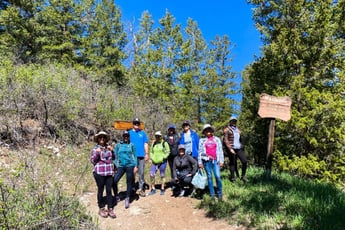
Josue Gonzalez Velez
Confíe En Nuestra Tierra (Trust Out Land): Financiando la Tierra de la que Dependemos
La conservación permanente de Brush Creek Valley Ranch y Open Space fue posible gracias a una larga...

